The Remarkable Story of Shooting the 2023 Exmouth Eclipse
![]()
My Exmouth eclipse expedition could be a case study on the ‘sunk cost fallacy’ or proof that even blind persistence can pay off. Either way, it is a saga.
The key ingredients for these images were:
- Sky-Watcher Esprit 150, Sony a1 (1575mm focal length, image scale 0.6 arc seconds/pixel)
- Sky-Watcher EvoStar 150, Sony a1 (1200mm)
- Sky-Watcher EvoStar 150, Sony A7 IV (930mm)
- Sky-Watcher Esprit 100, Sony A7 IV (550mm)
Yes, that’s one 4″ and three 6″ refractors plus two 8K Sony cameras out of a total of nine, delivering super high resolution and a lot of data!
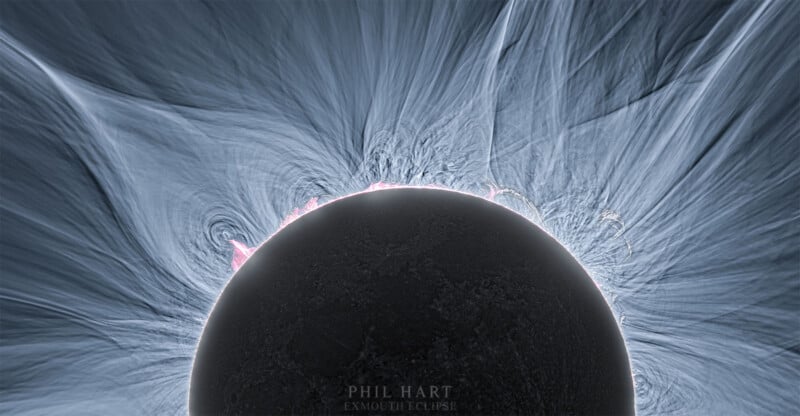
The story of one eclipse begins when the previous one ends. But it took me two years to process and publish my images and (must watch) video of the 2017 Great American Eclipse. So even without a pandemic I had no plans to be in Chile (x2) or on an Antarctic cruise for other eclipses in the years after that.
Destination Exmouth
Now Exmouth is as far from south-east Australia as you can get by land, and a nearly 5,000km road trip (each way) cannot be described as a ‘convenient’ eclipse on home soil. But it does mean you don’t have to be limited to checked-in baggage, and crossing the Nullarbor is a rite of passage for Aussies. While Exmouth has a favorable climate, there was only one place you (and everyone else) could be and no Plan B for bad weather.
From historical satellite imagery, I had estimated a 60% chance of clear blue skies on eclipse day, a 10% chance of a wipeout and the remainder a mix of partly cloudy conditions which might work out ok for visual observers but would be very risky for the high-res, big-data outcome I was aiming for. (Postscript: the statistics after our two weeks in Exmouth region were slightly worse, making this huge gamble look dicey in hindsight!)
And did I mention this eclipse was barely 50 seconds long!
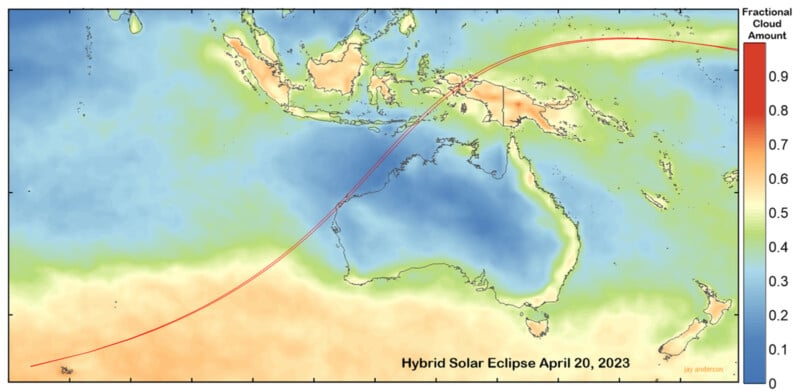
Why & How
What I learnt from capturing and processing the 2017 footage continued to simmer in the back of my mind. Technology progressed also. Teasing out tenuous details in the corona requires data — lots of data — and so an idea took shape of a ‘dragonfly‘ approach to eclipse imaging: multiple telescopes and multiple cameras to smash out hundreds of exposures and thousands of high-resolution 8K video frames, yielding orders of magnitude more data than I captured in 2017, even in an eclipse lasting less than a minute.
Several major supporters would be required to make this possible, and the first and most important of these was Will Godward at Sky-Watcher Australia. We had collaborated on gear reviews previously and in late 2021 (18 months before the eclipse) Will took surprisingly little convincing about the merits of loaning me two Esprit refractors and another EvoStar, in addition to one I’d been trialling for lunar eclipses already. Plus the CQ350 mount which I was reviewing, and my own EQ8-Rh. This whole crazy idea had no legs without this incredible support.
The ‘Avan’ was also purchased that spring and collected from Canberra once lockdowns ended. Costs of my own and on other’s behalf were now being sunk!
Planning Begins
Having signed up as a member of RACWA (Royal Automobile Club of Western Australia) using a friend’s Perth address (thanks Angus & Melina!), we were successful in booking a powered site at RAC Exmouth Cape Holiday Resort the minute bookings opened on 20th April 2022. With accommodation secured, this was now a real thing. (Postscript: Thanks to all the staff at RAC Exmouth Cape and the whole community – you put on a great show in style!)
![]()
In May, the marketing team for Sony Australia responded to my pitch and asked for more details about the eclipse expedition and how I proposed to put two 8K Sony a1 cameras to good use (plus two A7 IV cameras and one of my own). The response was written while in Covid isolation for an extra week at the end of a work trip to Hughenden (remote Queensland, four hours inland from Townsville).
Spring 2022 included foot surgery (both feet), floods and working with Xavier Jubier to reverse engineer the first of the new Sony cameras to work with Solar Eclipse Maestro (eclipse photography scripting/automation software). Although of sketchy value as a Plan B, I also booked remote campsites in Cape Range National Park on the other side of the North-West Cape (after a false start when the website crashed with eclipse chaser’s demand).
The idea that I would be ready to rehearse half of my approach to Exmouth during the Lunar Eclipse on 8th November 2022, including an Avan expedition, turned out to be fantasy. The weather forecast was marginal but did not provide a strong signal to head elsewhere, so I ended up in the ‘backyard’ at Mount Glasgow. I learned I was a long way behind where I needed to be.
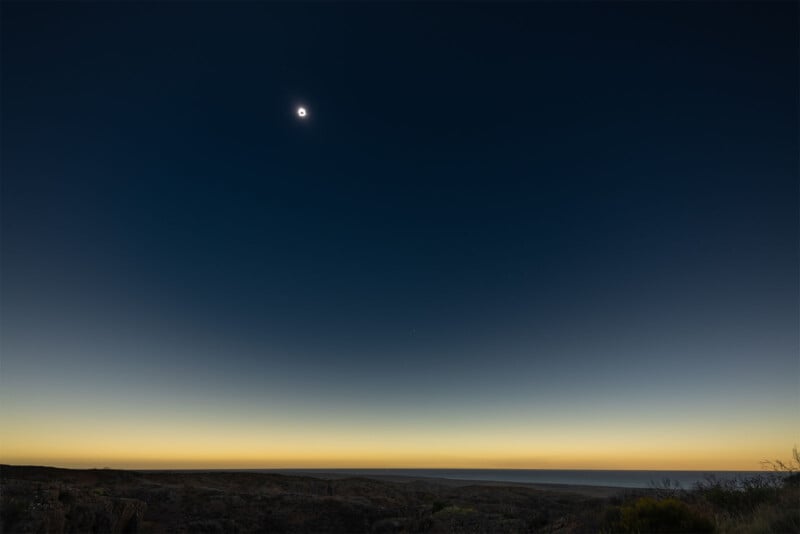
More costs were sunk on accessories for both photography and the Avan road trip, and time spent on tedious details like replacing the dodgy taillights on the Avan with LEDs. As always, there was a brief pause over summer to volunteer at Camp Cooinda and (less commonly) help defend a brief bushfire close to home. And major costs were sunk into a secondhand but carefully inspected Ford Everest to be the tow and payload vehicle for the trip – one more internal combustion engine than I had ever hoped to buy.
Much later than scheduled, combining all the gear and accessories for field testing finally started in February 2023. But then a major setback. A latent user issue (dating back to preparation for the lunar eclipse) resulted in a major piece of kit needing a hospital trip. I was physically in shock and rocking in my chair — I could not get my sophisticated eclipse photography plans in place with a delay of several weeks at this critical juncture. Remarkably, my friend Diego at Sidereal Trading was able to diagnose the problem and replace the part with a magical spare they had on the shelf. I was back up and running just a few days later. Thanks Diego!
By the end of February, I had received the last shipments of gear from Sky-Watcher and Sony and started commissioning it all. I was also testing and calibrating Limpet motorised focusers. In 2017 I was manually adjusting telescope focus to match the sharp temperature changes that occur during an eclipse. With multiple telescopes, I wanted that process automated, despite the complexity it introduced, as each of the four Limpet units required a PC or smartphone connection.
Not too surprisingly, but still the cause of enormous stress, there were further setbacks along the way. What had been planned as a full remote dress rehearsal of astronomy and touring gear on the March long weekend, turned out to be a dry run of just one quarter of the gear I would need to have run smoothly in Exmouth.
Back on Track
Finally, by the 18th March 2023 I had two hefty mounts running with four scopes and a fifth camera between them, plus three PCs and a spare smartphone for mount, camera and focuser control. On the 25th March, the final weekend of preparation, I only had time for a perfunctory test of the Sony a1 8K video capability with the Esprit 150 main imaging scope on a crescent Moon low in the shimmering evening sky (and now starting its final orbit to the eclipse). But it was better than no test at all.
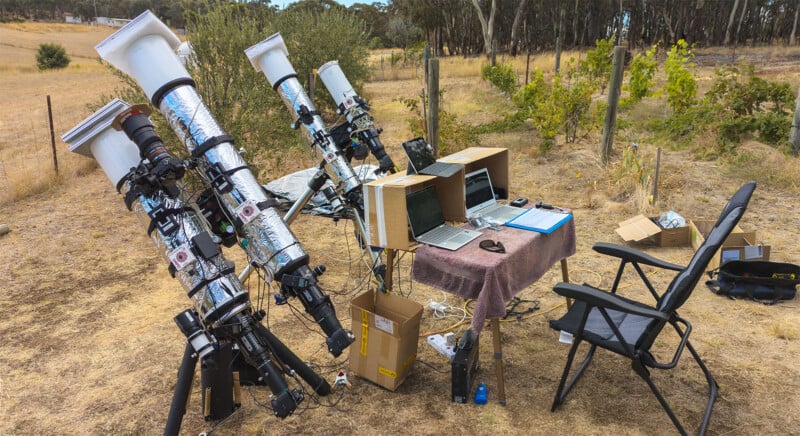
On the Road
Every single item of gear that was working in the yard was put into a quarantined area of the shed floor. After a brief work trip to the Gold Coast in the last week of March, I returned home and packed every item from that quarantine zone into the Ford Everest, ready for departure on the 1st April.
After a brief stop to meet Will and collect a more manageable field tripod for my EQ8 (which involved repacking nearly the entire contents of the vehicle), we continued the second day only for disaster to strike. The engine on the Ford Everest failed climbing the hills into Adelaide. Although soft at first, the ticking sound was alarming, and it didn’t take a lot of diagnosis to confirm worst fears. This vehicle was not going to Exmouth and 500kg of payload was still 3,800km away from where it needed to be. Karen and I may have gone on separate journeys since, but her support in these tough moments was never in doubt and I am extremely grateful for it.
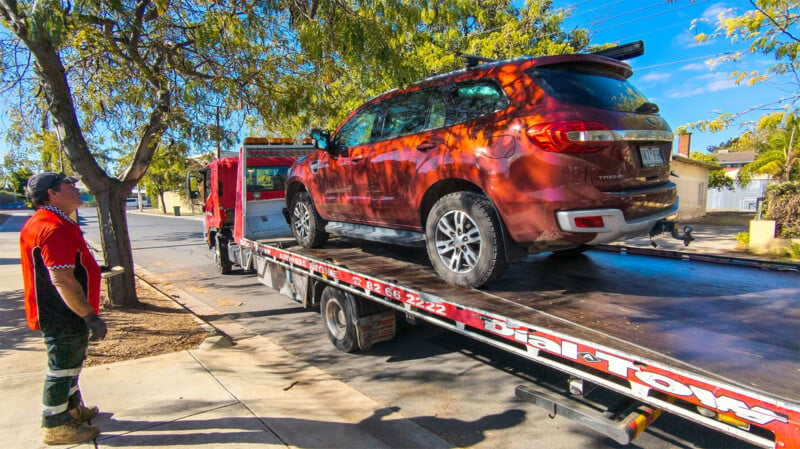
I was in despair, and in a Snowy Hydro 2.0 sized financial hole and likewise still digging. Hiring a tow vehicle for six weeks at short notice is impossible. Buying another secondhand 4WD wagon/ute and planning to trade it in afterwards (as with the Everest) was a big cash outlay but seemingly one of few options. And yet, the weather alone in Exmouth meant I was doubling-down on the roulette wheel and could still return with nothing. But I couldn’t turn back now – sunk costs be damned!
So, I am super appreciative that my employer stepped in as saviour, allowing me to commandeer the work ute for a trip across the continent (a lot more than incidental personal use!). Everest engine failure occurred on the Sunday. After visiting Ford dealers and drawing blanks the next morning, by Monday evening I was on a plane back to Melbourne and a late-night two-hour Uber ride to central Victoria. On Tuesday I drove to Adelaide for the second time, moved all the touring and astro gear across to the ute and we commenced again on Wednesday, three days behind schedule. (While we were away, the Everest engine was repaired for a five-figure sum and promptly sold on our return).
![]()
The shine of being on a road trip across the Nullabor really fades when you are one engine down, and the slack in the schedule had gone as well. But there was some new work to do – Xavier was back online, and I spent each night with sketchy internet, testing the latest scripts and sending logs back, before we finally got video control of the a1 working in SEM (Thanks Xavier!). This did necessitate a change to operation of two cameras from what I had been rehearsing and introduced a fourth computing device, but with the advantage that I no longer needed to operate anything during totality. Otherwise, after some brief adventures on the west coast, it was simply a relief to arrive in Exmouth as scheduled nearly two weeks later on Friday 14th April, with Cyclone Ilsa having just made landfall 500km further up the coast.
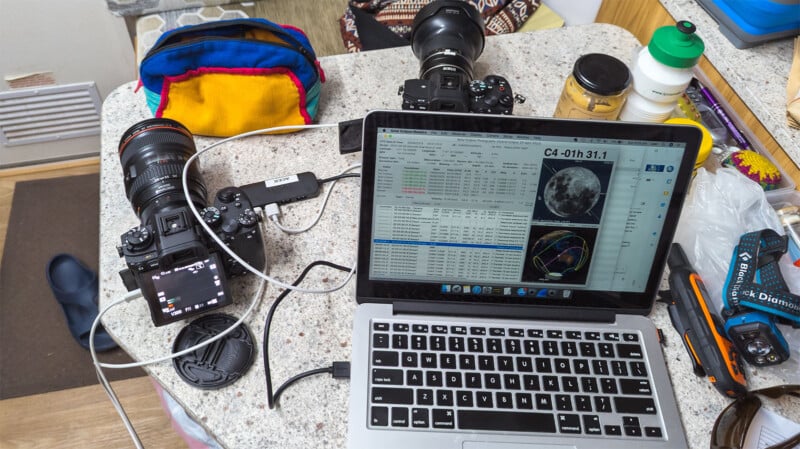
Exmouth!
There’s another story that involves an inquiry about transporting gun powder across the country, in full compliance with firearms and dangerous goods regs in three states, in exchange for a (very secure) local observing site, plus freight handling and mechanical advice (thanks Myron!).
But back on the first happy day of the road trip, I also discovered an old astronomy friend had a place in Exmouth as well. Although a little further north and with a few less seconds of eclipse, it was great to hang out for the week with Brett, Jasmine and Riley and friends. With a spare and air-conditioned room for gear, easy access to 240v power and a whole workshop of tools any remaining issues were quickly dealt with. The courtyard was secure, grassy rather than dusty like much of Exmouth (including the holiday park) and sheltered from the wind which was critical at focal lengths of a metre and more. It made the best possible observing base – thanks Brett and Jasmine!
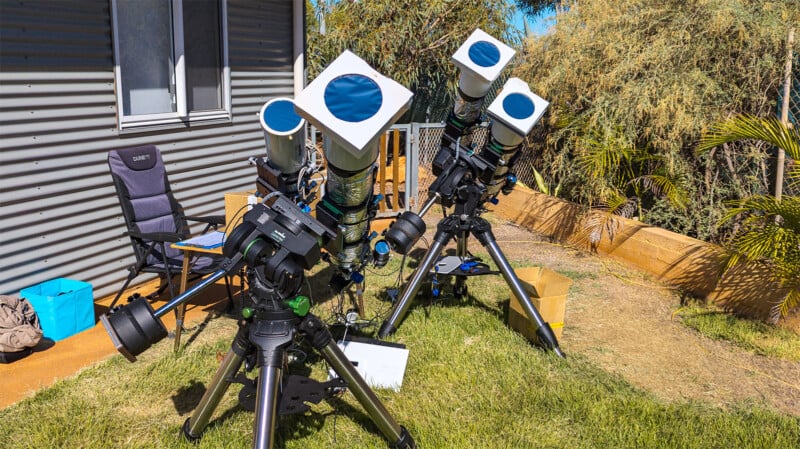
The weekend was spent unpacking and setting up gear in its new home, plus some location scouting. Then for the next three mornings in a row, I ran through a full rehearsal of the eclipse photography plans while baking in the Exmouth sun, teasing out issues on each day but feeling finally ready by the end. (The backup plan that I might quickly move all this to the Camp Range campsite if somehow that looked favored by the weather forecast was also revealed to be a foolish fantasy). The afternoons were spent road-tripping around the north-west cape and setting up remote cameras for timelapse video and composite imagery and the evenings used for cleaning sensors, recharging batteries and refining focus and polar alignment.
I’d got far enough ahead of schedule on the Wednesday afternoon that I could just get back to the first cameras I’d setup on the Monday on Charles Knife Rd, as I had a concern about the battery pack for the composite camera. That turned out to be fine, but the timer remote for the main timelapse camera was running 2% fast and was going to miss the whole show. I first had to reference the photos I’d taken during setup two days earlier to establish that the error wasn’t mine, then do some mental arithmetic to reset and offset the timer. If not for revisiting the scene, I would have missed the main timelapse sequence in my eclipse video (still pending!).
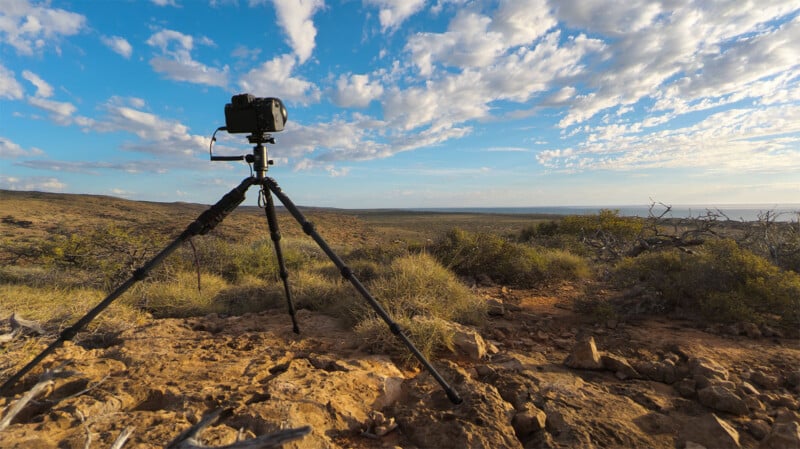
After a final focus calibration as the stars came out (as close to eclipse temperature as possible), I was able to enjoy a special evening at the Dark Sky Festival with The Waifs playing our favourite songs. The weather forecast that looked highly risky upon arrival in Exmouth had eventually come good — high cloud in the evening sky the night before the eclipse was in line with the models and I could sleep comfortable in the knowledge that eclipse day would bring sunny skies (but quite a bit of wind!).
Eclipse Day
On the day, every important piece of gear ran like clockwork (Thanks Sky-Watcher and Sony!). Aside from admiring what I could see on the back of the main cameras, I did not have to touch anything during totality and spent a good chunk of the 50 seconds looking at the prominences in 12 x 50 binoculars, stabilized this time as I knew from previous experience that my hands would be shaking. Honestly, though, it was never going to be about enjoying the moment. There was so much effort, energy, time and cost sunk into this venture, and a week of hard yakka in Exmouth itself, that it was purely relief to have the outcome in the bag.
The list of gear I had running looks much like I had envisioned originally and as sent in my ‘Christmas Wishlist’ to Will 18 months earlier. Five main imaging cameras in Exmouth, plus a phone recording the on-scene events. Then another three remote cameras scattered a hundred kilometres apart by road.
![]()
Fellow eclipse chasers and astrophotographers can judge these images on their merits, but for the few friends and family that will read this saga, let me justify this seemingly ridiculous effort by saying that I believe these are the highest resolution (white light) images of the solar corona ever captured, by anyone, anywhere (at least for another month until 8th April 2024). The only higher resolution imagery I know of is captured in UV by the Solar Orbiter spacecraft four times closer to the Sun than Earth! (let me know if I’ve missed something!).
The key elements of this eclipse imaging approach are worth repeating:
- Three six-inch and one four-inch refractors is a lot of glass to deliver maximum light and resolution to the cameras.
- Capturing more than a thousand 8K video frames at the full sensor resolution of two Sony a1 cameras provides a lot of data for the enhancement steps, even helping counteract the atmospheric ‘seeing’ at such long focal lengths.
- Four telescope and camera combinations allowed each camera to be dedicated to one primary exposure, allowing even the wider stills cameras to simply burst at a fixed shutter speed, gathering hundreds of exposures in well under 50 seconds (allowing for longer exposures around 2nd and 3rd contacts).
- The two main scopes were carried on the Sky-Watcher EQ8-Rh mount with high-resolution encoders. This meant no periodic error during 50 seconds of totality and facilitated accurate alignment and integration of the video frames.
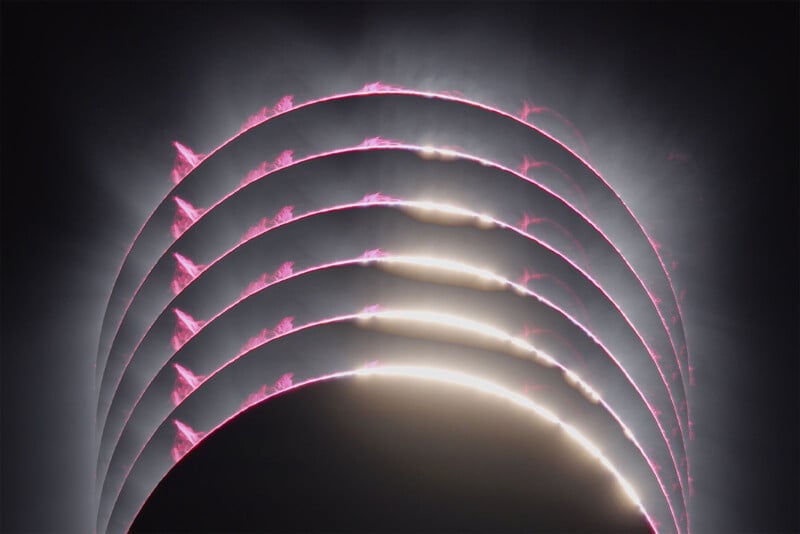
The duration of totality calculated by Solar Eclipse Maestro for my location was 49.5 seconds. The data captured in that time from each scope and all the cameras is:
- Esprit 150 / 1575mm: 1042 video frames at 1/125 sec, ramping to 1/2000 sec around 2nd and 3rd contact
- EvoStar 150 / 1200mm: 1200 video frames at 1/25 sec
- EvoStar 150 / 930mm: 135 RAW files at 1/8 sec
- Esprit 100 / 550mm: 53 RAW files at 1/4 sec, and 1/80 sec Diamond Ring sequences
- Sony A7 III / 135mm lens: 113 RAW files at 1/4 sec
- Sony A7 IV / 24mm lens: Near Yardie Creek for wide timelapse (1/25 sec) of approaching shadow
- Sony A7 IV / 20mm lens: Charles Knife Rd for wide timelapse (1/25 sec) of eclipse looking over Exmouth Gulf
- Sony A7 II / 50mm lens: Charles Knife Rd for 5 x 3ev bracketed composite
- Sony RX100 VII: Compact camera capturing video and stills on location in Exmouth
- Google Pixel 6 Pro: 20 minute video of equipment in Exmouth through totality
I messed up the framing for the composite image in a tight spot on a steep hillside — a bare pass on this one. And the compact camera stopped recording before totality (repeating previous experience that any element of the plan that hasn’t been rehearsed will fail!). But the main imaging cameras all worked perfectly.
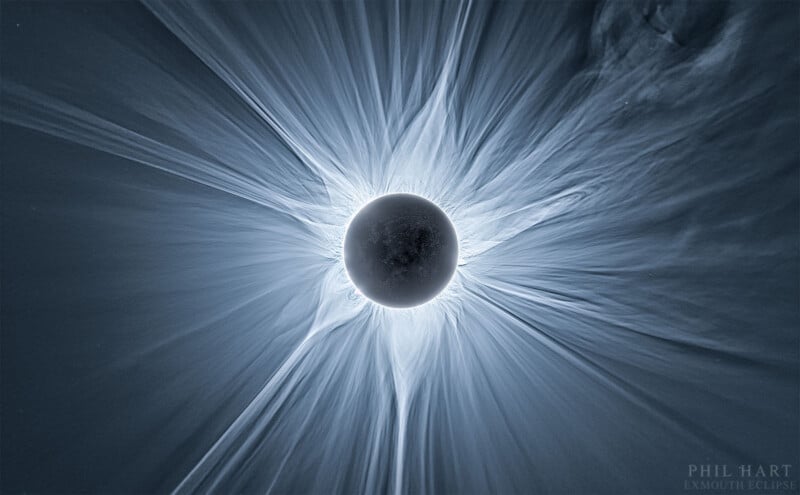
Earthshine on the lunar surface is an example of the power of the video data. Normally captured with a few long exposures of several seconds, with such a narrow/tight eclipse, the bright inner corona and prominences were grossly over-exposed and swamped much of the lunar detail. The best Earthshine data I have is the integration of 1200 video frames from scope #2 (1/25 sec, f8). These yield a net integration time of 48 seconds (the entire duration of totality) but with each frame being so short, it helped limit the light bleed from the solar features. The idea that you would use 1/25 sec exposures to capture Earthshine would previously have been considered absurd!
For anyone risking their life suggesting these are fake, I offer the image below of the scopes during totality with the solar corona visible on two camera screens as well as on the PC on the table, with the MacBook running Solar Eclipse Maestro to control two of the cameras visible on the ground.
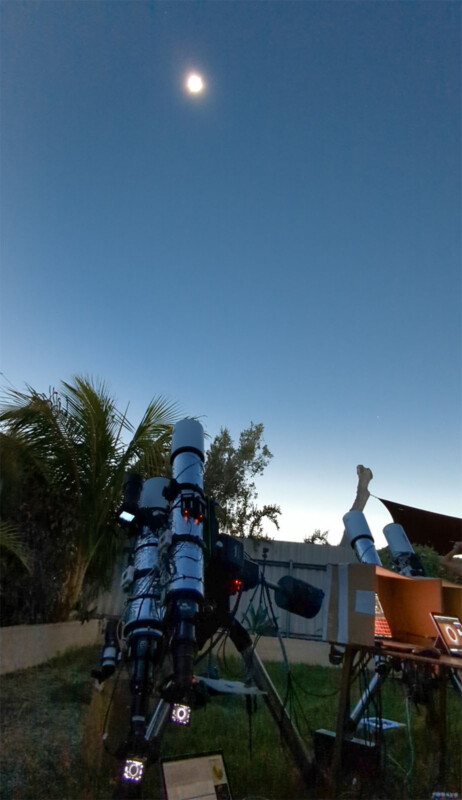
You should also check out what some likewise afflicted eclipse chasers have captured. Nicolas Lefaudeux set the resolution benchmark in 2017 with his remarkable image processing using custom developed software. Peter Ward also had a six-inch refractor in Exmouth and captured similarly high-resolution prominences. And Petr Horálek and pioneering academic Miloslav Druckmüller are an inspiration to many.
Image Processing with Colin Legg
Just as the support from Sky-Watcher and Sony Australia was essential in making the expedition possible, my friend and eclipse and space weather nut Colin Legg has been critical to all that happened afterwards.
After a long and torturous journey, one does not simply apply a filter and post an eclipse picture to Instagram. The whole endeavour is better described as reduction of data from a major scientific experiment. I’ve logged just shy of 300 hours on image processing (equivalent to seven weeks full-time work), which is why publication has taken nearly a year, but I had to publish before the 8th April 2024 eclipse in Mexico and the USA!
With unique data, the processing journey involves many iterations and backward steps before getting to a result that is aesthetically pleasing while revealing as much from the data as possible and maintaining integrity with it.
In 2017 I had relied primarily on the Larson-Sekanina filter in PixInsight to extract coronal detail. But this time, I got on a better track when I re-discovered a tried and tested approach in Photoshop published by Sean Walker in Sky and Telescope in 2020.
Having read some of the academic papers from Miloslav Druckmüller and Hana Druckmüllerová that Colin had been studying, my addition to Sean Walker’s technique was to add convolution in the radial direction, as well as the circumferential (rotational) blurring generally used in eclipse processing. I also used the rotationally blurred images to radially grade the image brightness, although this step didn’t make the final cut in most cases.
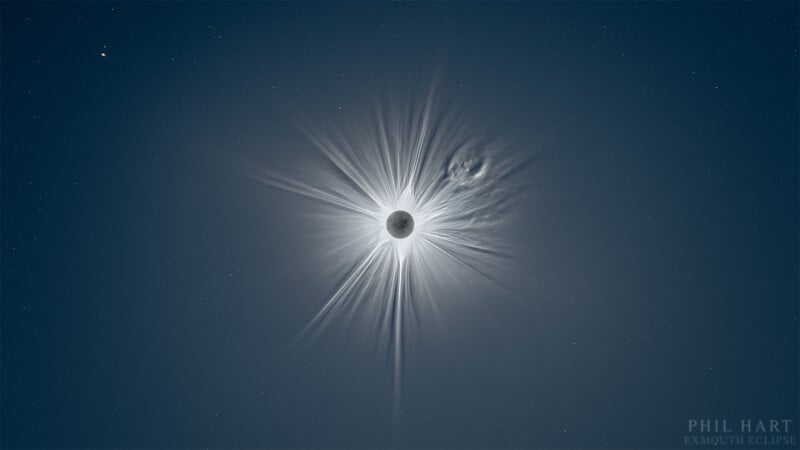
Software used is primarily PixInsight for image calibration and integration and Adobe Photoshop (plus some steps in GIMP) for the convolution and enhancement, using layers and masks to combine and optimise enhancement at various image scales. As far as possible, I tried to use image data to create all masks. There are very few manual brush strokes. There is no AI or synthetically generated image content, aside from Topaz DeNoise and cosmetic fixes for dust spots and extreme corners outside the imaging circle of the wider scopes. Druckmüller’s NAFE software was used often for comparison and is present for a few percent of detail enhancement in the 550mm field of view. At the end of my work, I also discovered Bray Falls’ tutorial, which is broadly similar but required lots more manual masking and brush strokes.
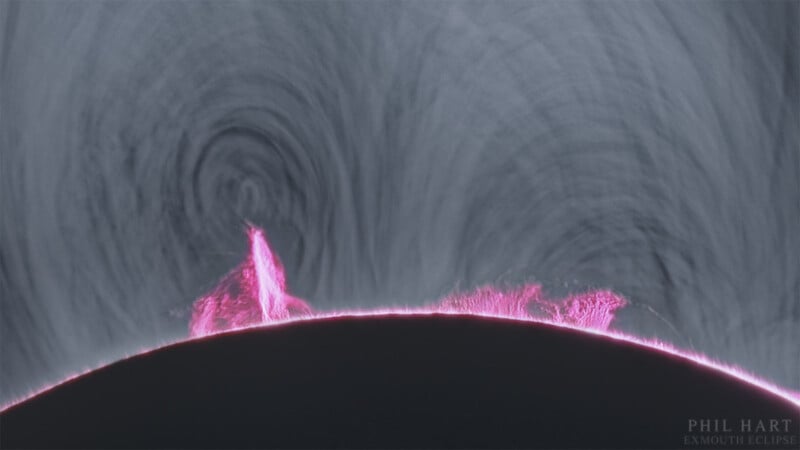
Colin Legg has gone deep on a journey to develop a purely computational approach to enhancing this same eclipse data. To recount just one example, in the early days of this collaboration, Colin relied on a Japanese friend to help him translate the software interface for StellaImage which had been used to great effect by Japanese eclipse photographers. After countless hours on that experimental path alone, Colin reverted to other approaches and saved me the bother of trying that myself.
As it currently stands, the images presented are processed purely with my own techniques, but the journey to that outcome would have stalled many more times and proven less successful without his collaboration. And it would have been less fun. It seems he has also a found a group of likeminded developers on the Cloudy Nights forum who are down the rabbit hole with him now. An example of Colin’s processing is shown below — the base layer is generated with a Multi-Gaussian Normalization (MGN) function, available in the SunPy python module, with a blending layer from Druckmuller’s NAFE software as an overlay. I hope Colin can publish more someday!
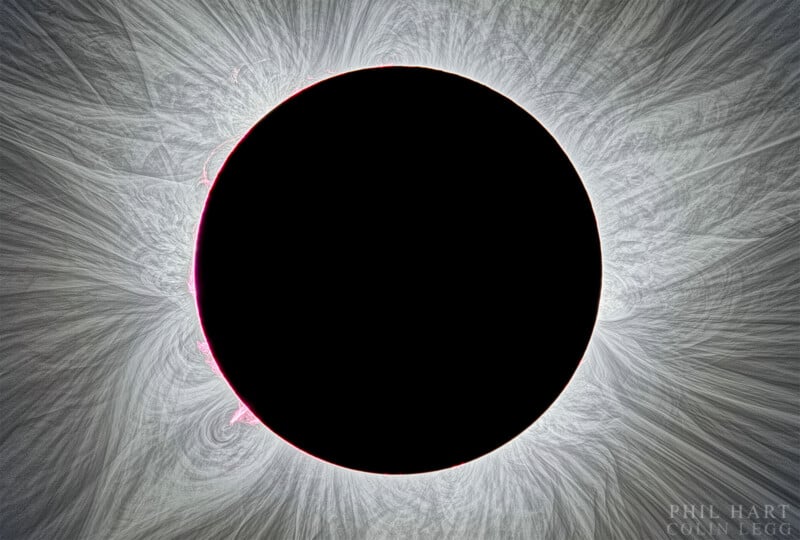
Persistence
This was never a solo venture and required the support of all the people named above and many more besides. While there may have been some bad luck, good fortune was also required and received along the way. Perhaps Roman philosopher Seneca was talking about a journey to Exmouth when they said “Luck is where the crossroads of opportunity and preparation meet.”
I’m very proud of the results, and I can laugh about the setbacks now, but this expedition pushed me to my limits. The best thing you can do to help me recover is spread the word!
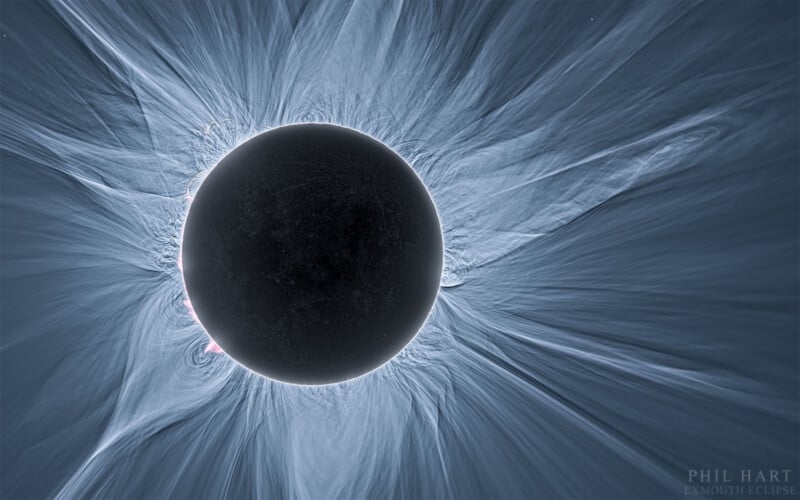
Check out the photos on SmugMug — Exmouth Eclipse Expedition (order prints if you like) and a separate Behind the Scenes album. And if you like the images, wait until you see the (8K) video! Follow me to hear when that is released.
About the author: Phil Hart is an engineer by day, astronomer by night. He is a passionate astro and night sky photographer.
Phil Hart has been enjoying and photographing the night sky for nearly thirty years. His award winning photos have been published in books, magazines and popular websites around the world. He is the three-time winner and now member of the judging panel for the David Malin Astrophotography Awards and author of the Shooting Stars eBook.
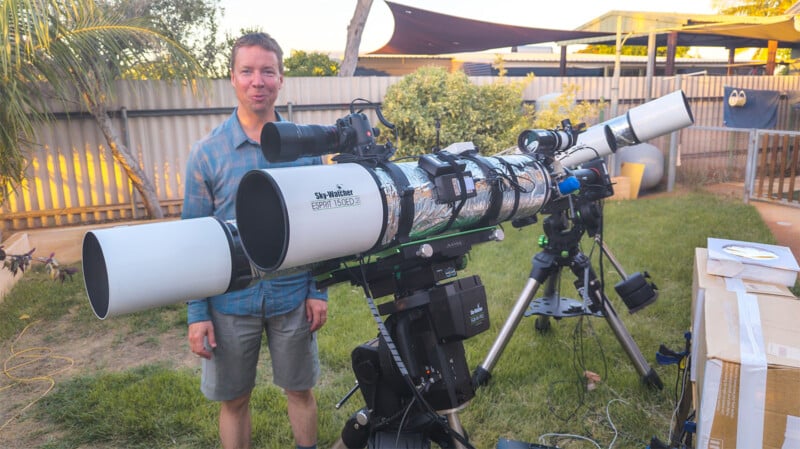
His first total solar eclipse in June 2001 in Zimbabwe changed the course of his life and led him to five years in Scotland where he got addicted to chasing the Aurora Borealis (despite the infamous Scottish weather). His love for such ephemeral astronomical events has gotten increasingly out of hand. What started with a removal company transporting gear to Cairns in 2012 for three Victorian photographers, became 12 cameras across Idaho and Wyoming in 2017. Then showing total disregard for any life lessons that may have been learnt from those expeditions, he wholeheartedly over-committed himself to the Exmouth solar eclipse in April 2023. He lived to tell the tale, but you’re going to have to wait for it to be published!
Image credits: All images by Phil Hart and used with permission under a Creative Commons CC BY-NC-SA 4.0 Deed.